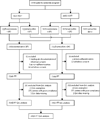Patient-reported outcomes with adjuvant exemestane versus tamoxifen in premenopausal women with early breast cancer undergoing ovarian suppression (TEXT and SOFT): a combined analysis of two phase 3 randomised trials
- PMID: 26092816
- PMCID: PMC4562429
- DOI: 10.1016/S1470-2045(15)00049-2
Patient-reported outcomes with adjuvant exemestane versus tamoxifen in premenopausal women with early breast cancer undergoing ovarian suppression (TEXT and SOFT): a combined analysis of two phase 3 randomised trials
Abstract
Background: The combined efficacy analysis of the TEXT and SOFT trials showed a significant disease-free survival benefit with exemestane plus ovarian function suppression (OFS) compared with tamoxifen plus OFS. We present patient-reported outcomes from these trials.
Methods: Between Nov 7, 2003, and April 7, 2011, 4717 premenopausal women with hormone-receptor positive breast cancer were enrolled in TEXT or SOFT to receive unmasked adjuvant treatment with 5 years of exemestane plus OFS or tamoxifen plus OFS. Gonadotropin-releasing hormone analogue triptorelin, bilateral oophorectomy, or bilateral ovarian irradiation were used to achieve OFS. Chemotherapy use was optional. Randomisation with permuted blocks was done with the International Breast Cancer Study Group's internet-based system and was stratified by chemotherapy use and status of lymph nodes. Patients completed a quality of life (QoL) form comprising several global and symptom indicators at baseline, every 6 months for 24 months, and then every year during years 3 to 6. Differences in the change of QoL from baseline between the two treatments were tested at 6 months, 24 months, and 60 months with mixed-models for repeated measures for each trial with and without chemotherapy and overall. The analysis was by intention to treat. At the time of analysis, the median follow-up was 5·7 years (IQR 3·7-6·9); treatment and follow-up of patients continue. The trials are registered with ClinicalTrials.gov, as NCT00066703 (TEXT) and NCT00066690 (SOFT).
Findings: Patients on tamoxifen plus OFS were more affected by hot flushes and sweats over 5 years than were those on exemestane plus OFS, although these symptoms improved. Patients on exemestane plus OFS reported more vaginal dryness, greater loss of sexual interest, and difficulties becoming aroused than did patients on tamoxifen plus OFS; these differences persisted over time. An increase in bone or joint pain was more pronounced, particularly in the short term, in patients on exemestane plus OFS than patients on tamoxifen plus OFS. Changes in global QoL indicators from baseline were small and similar between treatments over the 5 years.
Interpretation: Overall, from a QoL perspective, there is no strong indication to favour either exemestane plus OFS or tamoxifen plus OFS. The distinct effects of the two treatments on the burden of endocrine symptoms need to be addressed with patients individually.
Funding: Pfizer, International Breast Cancer Study Group, and US National Cancer Institute.
Copyright © 2015 Elsevier Ltd. All rights reserved.
Conflict of interest statement
All other authors declared no conflicts of interest.
Figures





Comment in
-
Interpreting quality-of-life data from the SOFT and TEXT trials.Lancet Oncol. 2015 Jul;16(7):749-51. doi: 10.1016/S1470-2045(15)00052-2. Epub 2015 Jun 16. Lancet Oncol. 2015. PMID: 26092819 No abstract available.
References
-
- Fallowfield L, Cella D, Cuzick J, Francis S, Locker G, Howell A. Quality of life of postmenopausal women in the Arimidex, Tamoxifen, Alone or in Combination (ATAC) Adjuvant Breast Cancer Trial. Journal of clinical oncology : official journal of the American Society of Clinical Oncology. 2004;22(21):4261–4271. - PubMed
-
- Cella D, Fallowfield L, Barker P, et al. Quality of life of postmenopausal women in the ATAC ("Arimidex", tamoxifen, alone or in combination) trial after completion of 5 years' adjuvant treatment for early breast cancer. Breast cancer research and treatment. 2006;100(3):273–284. - PubMed
-
- Fallowfield LJ, Bliss JM, Porter LS, et al. Quality of life in the intergroup exemestane study: a randomized trial of exemestane versus continued tamoxifen after 2 to 3 years of tamoxifen in postmenopausal women with primary breast cancer. Journal of clinical oncology : official journal of the American Society of Clinical Oncology. 2006;24(6):910–917. - PubMed
Publication types
MeSH terms
Substances
Associated data
Grants and funding
- U10-CA-69651/CA/NCI NIH HHS/United States
- U10-CA-37377/CA/NCI NIH HHS/United States
- 021039/PHS HHS/United States
- N01 CA032102/CA/NCI NIH HHS/United States
- U10 CA077202/CA/NCI NIH HHS/United States
- CA077202/CA/NCI NIH HHS/United States
- U10 CA021115/CA/NCI NIH HHS/United States
- U10 CA012027/CA/NCI NIH HHS/United States
- U10 CA180821/CA/NCI NIH HHS/United States
- CCSRI 015469/PHS HHS/United States
- U10-CA-69974/CA/NCI NIH HHS/United States
- U10-CA-12027/CA/NCI NIH HHS/United States
- U10 CA069651/CA/NCI NIH HHS/United States
- U10 CA032102/CA/NCI NIH HHS/United States
- U10 CA016116/CA/NCI NIH HHS/United States
- U24 CA075362/CA/NCI NIH HHS/United States
- U10 CA069974/CA/NCI NIH HHS/United States
- CA21115/CA/NCI NIH HHS/United States
- CA180821/CA/NCI NIH HHS/United States
- U10 CA037377/CA/NCI NIH HHS/United States
- CA16116/CA/NCI NIH HHS/United States
LinkOut - more resources
Full Text Sources
Medical
Miscellaneous

